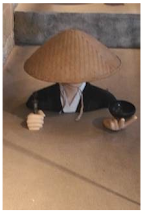Chi and Charity: It's Called "Currency" for a Reason
When the gross economic melt-down began its grave spiral and the news stories focused on how once prosperous was now less prosperous and the poor were poorer, I heard something more than a rhyme connecting health and wealth.
When one is ill and seeks the advice of a practitioner of Traditional Oriental / Chinese Medicine (TCM), the doctor will assess the currency of the patient's chi, the life force, to make a diagnosis and prescribe treatment. Chi is the essence of vitality that flows through channels or meridians in our body. When illness, defined as a disharmony, occurs, the doctor may stimulate a point to affect healing, in effect “jump starting” what might be sluggish or blocked. Chi moves substance, such as blood and bile, phlegm and lymph, and enables organs to remain intact; in short, it keeps the body functioning in the world. It's quite simple, requiring no belief in esoterica nor any other effort on our part: no chi, no life.
In TCM acute, sharp, specific pain is defined as a condition of excess, possibly causing stagnation of chi in one place. On the other hand, pain that is dull, achy, perhaps chronic and overall sluggish is usually connected with a deficiency of chi.
Money also needs to flow for an economic “corpus” to be healthy. No flow of money, no life.
In parallel, the pain felt among individuals who consider themselves wealthy is different than that of the poor. All of a sudden, your stock took a dive beyond the X – axis on the chart! There goes the endowment! But for someone who’s “... been down so long it looks like up to me,” to quote lyricist / singer Richard Fariña, the pain of another day eating processed snacks for dinner from the gas station mini-mart is numbing and constant: there isn’t anything that doesn’t hurt like yesterday.
Money is called “currency” for a reason; it was never meant to be stockpiled. And while we can imagine the Feds printing more when we need it, there isn't an endless amount of it, if all bets are called in. When “value” ceases to flow, there is disharmony. It is dangerous and creates problems of both deficiency and excess among the “have nots” on one hand and “have too muches” on the other, leading to the economic illness in which we find ourselves.
The stimuli packages implemented by the Federal government resemble the application of acupuncture to the various channels of our economy. A prick here, another there is supposed to crank up the currency and to return harmony to our system. But all we are being challenged to do is to consume more by spending more.
I propose that this will only work within one layer of a multi-dimensional system. The continuum from wealth to less wealth is not the same as that of wealth to poverty. Robert K. Merton theory of the compounding of iniquity, as noted in The New Yorker (“Talk of the Town”, October 10, 2005) is apropos. We must reconnect our meridians.
Wouldn’t it be better over-all if the funds pumped into the economy were designated in a manner to balance consumer and charitable activities? A two tier, inclusive system would provide incentives for us to support nonprofit organizations as well as our big-box store. Within the charitable tier, I see yet another dynamic, symbiotic dual system: lump-sum “bail-out” packages for nonprofits providing basic human needs (food, clothing, shelter, transportation, health care, etc.) made directly from the government, and stronger individual and corporate tax incentives to encourage donations to support nonessential needs, such as the arts, sciences, etc. This is not to diminish the value of the latter in a society that has a fine quality of life, but everything needs to be brought back into harmony so that every body will feel strong enough to begin to enjoy itself a bit.
No matter what, Don't Forget to Ask for the Money!
Tuesday, May 19, 2009
Chi and Charity: It's Called "Currency" for a Reason
Labels:
acupuncture,
charity,
chi,
consumerism,
currency,
nonprofit,
stimulus,
Traditional Chinese Medicine
Subscribe to:
Post Comments (Atom)

The Oct 24, 2011 New Yorker cartoon on page 51 illustrates one of the issues in this posting perfectly.
ReplyDeleteright on, Lauren! great cross-cultural insight...
ReplyDelete